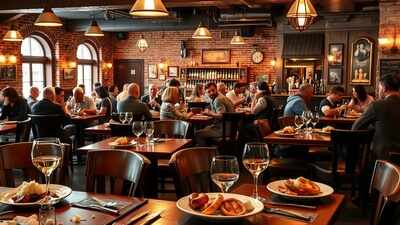Auerbachs Keller: Luther and Goethe’s victim becomes 500 world news

 Auerbach: A friend Martin Luther‘S
Auerbach: A friend Martin Luther‘SDuring the Easter 1525, the leapzing physician and university professor Heinrich Stromer von orback served alcohol to the seller for his Keller – the first time – the first time.
He was a friend with the church reformer Martin Luther, who also saw Auerbachs Keller in the early 16th century and is said to have hidden many times from his enemies.
This year during the Easter, the major 500 -year anniversary ceremony was held, and it included the so -called great feast.
“We copied it from Goethe,” Pipar said. “Ek big ‘shlampamp,’ is a feast, food trinity, drinking and good company.”
“We celebrate in long tables like the old days,” the paper said, how is food served in boards and bowls like the 18th century.
Goethe’s ‘Fost’ set in Auerbach’s Keller
Goethe’s drama is about the aging Melancholi teacher Heinrich Fost, who sells his soul to become a young man to Devil Mefisto: “Fustian Bargain.”
Fost gets a new enthusiasm for life, but it is not free from the evil of Mefisto. For example, when the Fast Youth Tampering and Plays them, she kills her illegitimate child, is arrested and arrested in jail for the redemption of God.
Mefisto is also for mischief in the scene set in Auerbachs Keller. To bring the fous to “Meera Company,” he connects delicious wine in front of some drinking colleagues before getting out of the basement on a liquor barrel.
For 30 years, actor Hartmut Muller is taking guests through a popular “barrel basement ceremony” tour in the barrel basement of 9 meters (30 ft) restaurant under the ground. As a “barrel seller master”, he guides visitors through the history and vaults of the building.
“In an advanced hour, we then pass through a separate door from this barrel basement, which go back to the kitchen of the witch,” the paper said while describing a small shovel 12 meter underground.
This is the place where guests – such as Goethe’s play – is given a rejuvenating drink.
Dr. Inspired by Fastus Legend
Goethe did not invent his fustian barrel ride; This idea was a magician Dr. The Fastus is derived from the 16th century folk tale, which sells his soul to Satan for special powers.
In the barrel basement, Goethe saw two wooden panels of 1625, with Dr.. The legendary barrel ride of Fostus was depicted. They are said to have tried to maneuver and make fun of the barrels weighing over the liquor basement. He made a condition that he could ride the barrel.
“Goethe was so fascinated by these two wooden panels that he was hanging there that he wrote to us in the drama,” said the paper.
In the 18th century, the restaurant was still purely a wine bar. In those days, the liquor was not bottled up, but was served from the barrel stored in the basement.
Till the 19th century, there was no cooking in Auerbachs Keller, the paper said.
‘Bakh’s Buke Fast’ at Lipjig Bach Festival
One of the anniversary events is “Bakh Ki Bust”, a kind of music comedy by Michael Maul, director of Bakh Festival.
Johan Sebastian Bakh from 1723 was the Cantor of the St. Thomas Church in Leapzig, which was until the end of his life in 1750. His daily traffic to do his work also took him to the last of Auerbachs Keller. Every year in June, the city celebrates Bakh Festival in honor of Bakh.
Maul told DW, “A lot of music is mentioned in Goethe’s Bust, without Goethe specified what it is.” Goethe greatly appreciated Bakh’s music, Maul said, whose drama is properly played by Bakh with curves and cantates.
The world premiere of “Bakh Ke Fost” with singers, musicians and actors will be in a large hall of Auerbachs Keller on June 15 as part of the back festival.
The anniversary of the historical restaurant will be celebrated throughout the year.
Close
Log In




